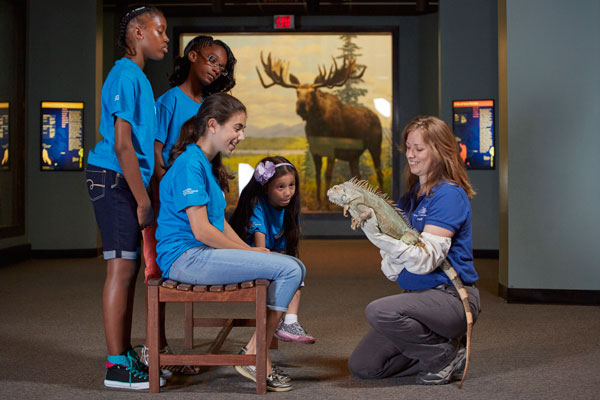By Mary Alice Hartsock
Caitlin Halligan is drawn to “problem students.” She doesn’t mind the ones that are too chatty, and she is patient when others make a mess. She especially likes the pupils that are just plain grumpy.
Lots of teachers help their students to stop passing notes, cutting class, and bullying their classmates. Halligan’s job is a little different. In addition to her students’ occasional bad moods, she’s also helping address behaviors such as showing off onstage and even biting. She certainly has her hands full as training and enrichment keeper for the Academy’s live animals.
Romeo the crow was the perfect challenge. From the day he arrived at the Academy, Romeo just didn’t like Halligan. When she was around, he was irritable, unfriendly, and even a bit threatening. Understandably frustrated, Halligan turned to fellow behavioral specialists for advice and began troubleshooting to build a rapport with Romeo.
“I love learning to communicate with animals based on their behaviors,” she says. “It’s like a puzzle, and you have to figure out what patterns might cause problem behaviors.”
First, the pair worked on relationship building. Halligan sat quietly in Romeo’s enclosure until he began to trust her. She soon noticed that he picked up on her moods, both good and bad, and he adjusted his own behavior accordingly. With this added awareness, Halligan made a breakthrough with Romeo. He now says “good boy” on command and even mimics her sounds with his mouth.
 Over the years, Halligan has befriended most of the Academy’s live animals. From birds to bunnies and turtles to snakes, she works to keep the animals content so that they train and perform well with the Academy’s educators.
Over the years, Halligan has befriended most of the Academy’s live animals. From birds to bunnies and turtles to snakes, she works to keep the animals content so that they train and perform well with the Academy’s educators.
Halligan’s interest in animal behavior developed while she worked in a primate lab at Franklin and Marshall College. During a summer internship at Zoo New England, she focused solely on animal enrichment and brought back much of what she had learned to her undergraduate lab. She even volunteered for two summers in Holland at a primate and exotic mammal sanctuary, where she worked with a team to build enrichment activities for all of the animals.
 Halligan maintains a 12-month calendar of enrichment activities for our animal groups to help our keepers and volunteers take care of them. She knows the vultures like to tear apart boxes, the barn owl prefers to stomp through white paper, and the armadillos enjoy pushing debris into their houses. The bunnies like to pull greens off a clothesline, and the midland rat snake is content when curled up in damp Spanish moss. Barton the porcupine is happiest relaxing with a teddy bear or pillow after a meal of fruits and veggies dangling from a branch.
Halligan maintains a 12-month calendar of enrichment activities for our animal groups to help our keepers and volunteers take care of them. She knows the vultures like to tear apart boxes, the barn owl prefers to stomp through white paper, and the armadillos enjoy pushing debris into their houses. The bunnies like to pull greens off a clothesline, and the midland rat snake is content when curled up in damp Spanish moss. Barton the porcupine is happiest relaxing with a teddy bear or pillow after a meal of fruits and veggies dangling from a branch.
In addition to redirecting unwanted behavior and enriching animals’ daily routines, Halligan also trains animals to perform positive behaviors so they can appear as the Academy’s live animal ambassadors. She is delighted to share our animals’ best qualities and quirks onstage. She hopes that her live animal shows inspire visitors’ curiosity, love, and respect for the animals and encourage questions about protecting animals in the wild.
 “This is a perfect dream position, because I get to work with enrichment as well as teaching,” Halligan says. “I am proud of the animals I work with, and I want to show them off!”
“This is a perfect dream position, because I get to work with enrichment as well as teaching,” Halligan says. “I am proud of the animals I work with, and I want to show them off!”
Teenagers ages 13–16 can get to know Halligan and some of our animals even better during Academy Animal Husbandry Camp on August 8–12. During this brand-new camp, participants will meet live animals, learn about handling and care, attend a wildlife rehabilitation field trip, and work with Academy staff to help prepare a naturalist presentation for Academy guests. Learn more.
This article originally appeared in the summer 2016 issue of Academy Frontiers.

